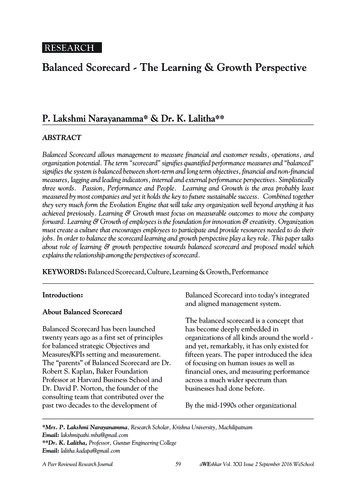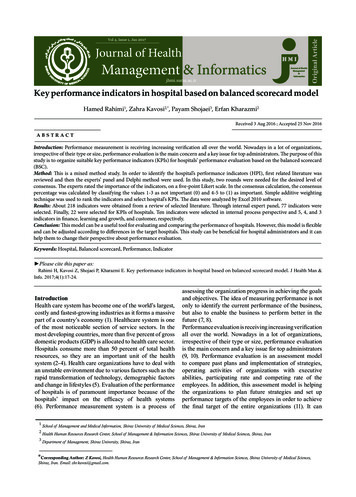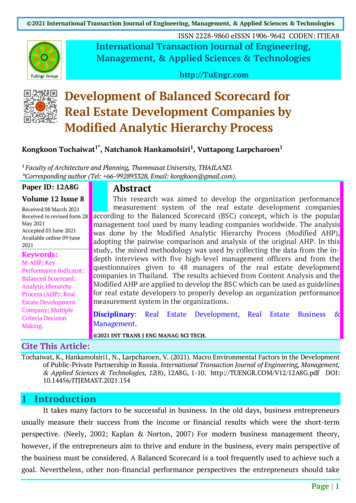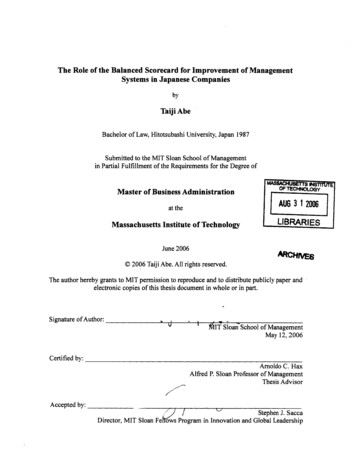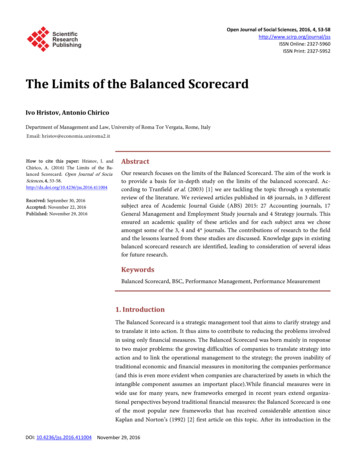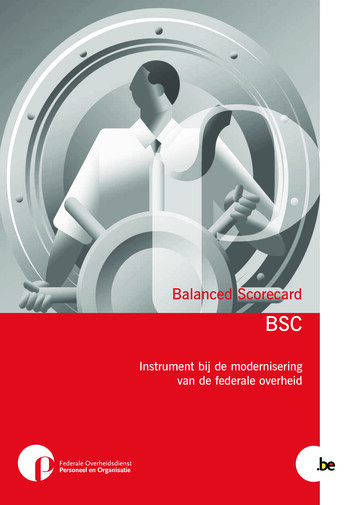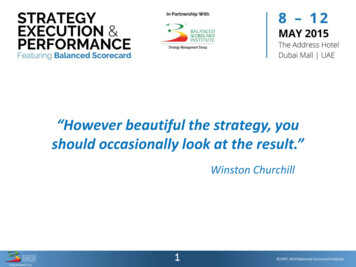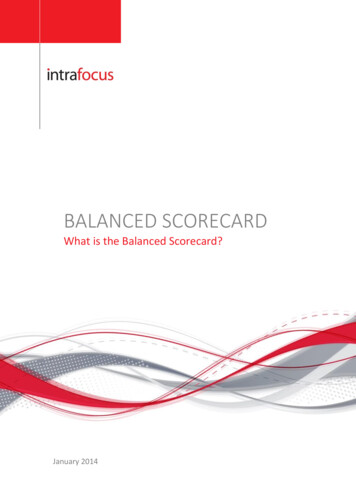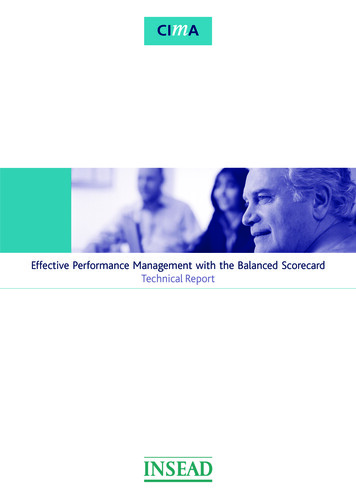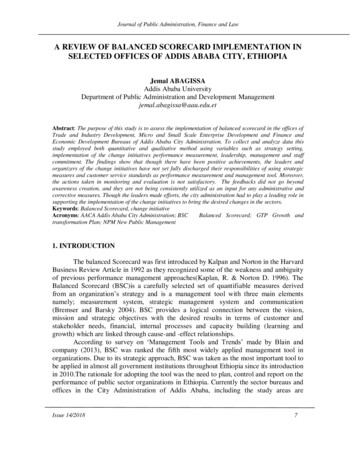
Transcription
Journal of Public Administration, Finance and LawA REVIEW OF BALANCED SCORECARD IMPLEMENTATION INSELECTED OFFICES OF ADDIS ABABA CITY, ETHIOPIAJemal ABAGISSAAddis Ababa UniversityDepartment of Public Administration and Development Managementjemal.abagissa@aau.edu.etAbstract: The purpose of this study is to assess the implementation of balanced scorecard in the offices ofTrade and Industry Development, Micro and Small Scale Enterprise Development and Finance andEconomic Development Bureaus of Addis Ababa City Administration. To collect and analyze data thisstudy employed both quantitative and qualitative method using variables such as strategy setting,implementation of the change initiatives performance measurement, leadership, management and staffcommitment. The findings show that though there have been positive achievements, the leaders andorganizers of the change initiatives have not yet fully discharged their responsibilities of using strategicmeasures and customer service standards as performance measurement and management tool. Moreover,the actions taken in monitoring and evaluation is not satisfactory. The feedbacks did not go beyondawareness creation, and they are not being consistently utilized as an input for any administrative andcorrective measures. Though the leaders made efforts, the city administration had to play a leading role insupporting the implementation of the change initiatives to bring the desired changes in the sectors.Keywords: Balanced Scorecard, change initiativeAcronyms: AACA Addis Ababa City Administration; BSCBalanced Scorecard; GTP Growth andtransformation Plan; NPM New Public Management1. INTRODUCTIONThe balanced Scorecard was first introduced by Kalpan and Norton in the HarvardBusiness Review Article in 1992 as they recognized some of the weakness and ambiguityof previous performance management approaches(Kaplan, R. & Norton D. 1996). TheBalanced Scorecard (BSC)is a carefully selected set of quantifiable measures derivedfrom an organization‟s strategy and is a management tool with three main elementsnamely; measurement system, strategic management system and communication(Bremser and Barsky 2004). BSC provides a logical connection between the vision,mission and strategic objectives with the desired results in terms of customer andstakeholder needs, financial, internal processes and capacity building (learning andgrowth) which are linked through cause-and -effect relationships.According to survey on „Management Tools and Trends‟ made by Blain andcompany (2013), BSC was ranked the fifth most widely applied management tool inorganizations. Due to its strategic approach, BSC was taken as the most important tool tobe applied in almost all government institutions throughout Ethiopia since its introductionin 2010.The rationale for adopting the tool was the need to plan, control and report on theperformance of public sector organizations in Ethiopia. Currently the sector bureaus andoffices in the City Administration of Addis Ababa, including the study areas areIssue 14/20187
Journal of Public Administration, Finance and Lawemploying BSC to improve their performance. According to the strategic manual (2010),Addis Ababa City Administration, justifies the launching of balanced scorecard as a toolto build result based measurement system and develop new attitude of employees to bemeasured only through their results. BSC design and implementation involves a complexset of steps, perspectives and key performance indicators. Thus, it requires anunderstanding of its methods and applications both theoretically and practically.Therefore, the major rationale for undertaking this study is the curiosity to check theeffectiveness and challenges of BSC implementation in public sector with particularreference to Trade and Industry Development, Micro and Small Scale EnterpriseDevelopment, and Finance and Economic Development Bureaus of the cityadministration.1.2. Statement of the problemMuch of the empirical literature on BSC concerns its private sector adoption andthere have been fewer studies of BSC applications in the public sector. Many of thestudies focus on the motivation for adopting BSC, nature of performance indicators, andthe perceive benefits. However, studies on the implementation of BSC in public sectororganizations are erratic. Moreover, though there are some evidences about theachievements and challenges of implementing the BSC at the national level, still little isknown about the achievements and challenges of the change initiatives at the AddisAbaba City Administration (AACA).This study, therefore, seeks to assess the extent of BSC implementation, itssuccess and challenges in the selected offices of Addis Ababa City Administration. Tothis effect, the study gives answers the following questions.- How is the BSC being implemented in the selected bureaus?- What are the major achievements gained by BSC implementation?- What are the major challenges encountered in the implementation of BSC?1.3. The objective of the studyThe general objective of this study is to assess the implementation of BSC in theTrade and Industry Development Micro and Small Scale Enterprise Development, andFinance and Economic Development Bureaus of city administration. The study focuseson the major aspects of BSC such as strategy, leadership, effective communication;performance monitoring, staff commitment and challenges encountering the offices inimplementing the change initiatives.The specific objectives of the study are:- To assess the implementation of BSC in the Trade and Industry Development, Microand Small Scale Enterprise Development, and Finance and Economic DevelopmentBureaus- To identify and examine major achievements gained so far from implementing BSC- To identify and analyze major challenges that the organizations faced in theimplementation of BSCIssue 14/20188
Journal of Public Administration, Finance and LawBSC is major initiative of the federal government and its cooperating partners (cityadministrations and regional bureaus). However, this study is limited to a randomlyselected three sector bureaus of the Addis Ababa City Administration which arepresumed to have implemented BSC in a full-fledged manner.1.4 MethodologyQualitative and quantitative approaches are the two main approaches used in thisstudy. Quantitative research is often based on measurable numbers. All phenomena is,however, not measurable and a qualitative approach is used for in-depth assessment ofsome variables.1.4.1 Study PopulationThe target population includes employees, leaders, and customers of AACAworking at the Trade and Industry Development, Micro and small scale EnterpriseDevelopment, and Finance and Economic Development Bureaus of the cityadministration. Hence, the population of the study is grouped in to top leaders (bureauheads and core processes owners of the sector bureaus), middle level leaders (subprocesses owners), civil servants and customers of the bureaus.There have been atotal of260 employees and managers in the three offices.There are 105leaders and 25 employeesin Trade and Industry Development Bureau: 14 leaders and 36 employees in Micro andSmall Scale Enterprise Development Bureau: and 23 leaders and 57 employees inFinance and Economic Development Bureau.1.4.2 Sample sizeSimple random sampling was chosen for conducting the study. The followingsamples are selected from each sector: From Trade and Industry Development Bureau(leaders 57, employees 20), from Micro and Small Scale Enterprise DevelopmentBureau (Employees 21, leaders 10), from Finance and Economic Development Bureau(leaders 20, employees 27),and the sum of the sample respondents is 155. Focus groupdiscussions were also held with the coordinators of the change initiatives (Monitoring,Support and Measurement sub-process owners) of the three sector bureaus.1.4.3 Data Collection TechniquesThe major instruments used to collect data were questionnaires. The questionnairewere prepared to collect data from different groups of employees and leaders about theBSC implementation status and challenges observed since its implementation.A structured questionnaire arranged in standardized 5-point Likert‟s scale were given tothe participants to respond to each question. Closed ended questions were also providedto the respondents for issues that cannot can be answered in absolute or relative way.1.4.5 Data analysisThe information collected from both primary and secondary data sources throughreview of different documents as well as survey questionnaires were organized andIssue 14/20189
Journal of Public Administration, Finance and Lawnarrated. To be specific, opinion of respondents‟ to the questionnaires were summed upby frequency counts and then converted into percentages. The results of the survey wereanalyzed using descriptive statistics to interpret the 5 point Likert scale type responses.Datawere presented using tables, charts, figures where necessary and generalizationswere made and presented.2. LITERATURE REVIEWBalanced scorecard is a management tool that enables an organization to translateits vision and strategy into a tangible set of performance measures. However, it is morethan a measuring device (Kaplan and Norton 1996). It is a strategic planning andmanagement system that is used in business and industry, government, and nonprofitsorganizations to align business activities to the vision and strategy of the organizationimprove internal and external communications, and monitor organization performanceagainst strategic goals. The balanced scorecard was developed by Robert Kaplan, anaccounting professor at Harvard University, and David Norton, a consultant in Boston. In1900s, Kaplan and Norton led a research study of a dozen companies exploring newmethods of performance measurement. The drive for the study was a growing belief thatfinancial measures of performance were ineffective for the modern business enterprise.They discussed a number of possible alternatives but settled on the idea of a scorecardfeaturing performance measures capturing activities from throughout the organizationcustomer issues, internal business processes, employee activities, and of courseshareholder concern (BSC institute 2015).The key claims success by Kalpan and Norton (1996) are that the BSCdemonstrates link to strategy, cause and effect relationships and balance between BSCmetrics. They also stated that the BSC is used as a communication tool, a measurementtool or a strategic management tool (Kalpan and Norton 2001). A key conclusion of theresearch was that in order to be successful, a company has to address long term issuesand not simply rely on producing good short term results. Kalpan and Norton argue thatfinancial measures were too one sided and not relevant to many levels in the organizationand that reliance only on financial measures may affect the ability of organizations tocreate value (Niven, 2006). Moreover, Kalpan and Norton (1999) argue that focusingexclusively on financial performance measurements worked well in the area ofindustrialization, but in the era where new trends are emerging, financial measurementsare not enough. Kalpan and Norton (1992) made an analog with an airplane cockpit. Theyexplain that for the complex task of navigating a pilot, the pilot should rely on a numberof indicators and instruments to reach the destination safely, and efficiently. He needsdetailed information about fuel, air speed, pressure, altitude, destination, and otherindicators that summarize the current and predicted environments. Relying only on oneinstrument could be fatal. The same can be said for organization. Managers shouldrecognize the need to track performance in several areas.Thus, the Balanced Scorecard (BSC) is specific tool that allows managers todefine and implement a set of financial and nonfinancial indicators in a balanced way toassess an organization's performance from four viewpoints. The balanced scorecardIssue 14/201810
Journal of Public Administration, Finance and Lawshould therefore provide answer to four basic questions that look at the business fromfour important perspectives (Kaplan and Norton, 1992).These are customer perspective,internal perspective, financial perspective and learning. The details are discussed below.2.1 The four balanced scorecard perspectivesWith the BSC framework, four categories of measures are identified in order toachieve balance between the financial and non-financial, between internal and externaland between current performance and future performance (Kaplan et al., 1992).Figure 1 The standard BSC model and its assumed causal relationshipsSource: Kaplan, R.S. and Norton, D.P. 1996.Kaplan and Norton do not disregard the traditional need for financial data. Timelyand accurate funding data will always be a priority, and managers will do whatevernecessary to provide it. In fact, often there is more than enough handling and processingof financial data. With the implementation of a corporate database, it is hoped that moreof the processing can be centralized an automated. However, the point is that the currentemphasis on financials leads to the “unbalanced” situation with regard to otherperspectives.2.1.1 The Description of the Four PerspectivesIssue 14/201811
Journal of Public Administration, Finance and LawBalanced Scorecard concept offers to look at an organization‟s strategy from thefollowing points of view (perspectives).1. The Financial PerspectiveTimely and accurate funding data will always be a priority, and managers will dowhatever necessary to provide it. However, the point is that the current emphasis onfinancials leads to the “unbalanced” situation with regard to other perspectives. There isperhaps a need to include additional financial related data, such as risk assessment andcost-benefit data, in this category.2. The Customer PerspectiveOf the four BSC perspectives, the customer is at the core of any business and iscrucial to long-term improvement of the company performance (Kaplan et al., 1992). Thecustomer perspective is a core of any business strategy which describes the unique mix ofproduct, price, service, relationship, and image that a company offers (Kaplan et al.,2001). The customer perspective defines how the organization differentiates itself fromcompetitors to attract, retain, and deepen relationships with targeted customers. The valueof the customer perspective is crucial because it helps an organization connect its internalprocesses to improved outcomes with its customers (Kaplan and Norton, 2001).Internal Business ProcessInternal business process measures relate specifically to the operational processesof the business unit. Internal business is based on the motion that to satisfy customers andearn a financial return, the business must be efficient and effective at what it does. Theinternal process measures are typically based on the objective based on the objective ofthe most efficiently and effectively producing products or services the meet customers‟needs. (Kaplan et al,. 1996).Learning and Growth MeasuresRepresent the employees as part of the four pillars used to measures performancewith the BSC framework. The innovation and learning and learning perspective is allabout developing the capabilities and processes needed for the future. In the aviationservice, for example for a business to succeed not only must it effective carry out dailytransactions but it must also continually improve in terms of the value and cost of itsofferings. This innovation process can be measured in a variety of ways. These mayinclude the speed of transactions, or the number of people involved in a particulartransaction, etc. again, the choice depends on what is critical for the success of eachparticular business (Kaplan et al., 1996). Acknowledging that performance measuresrelating to learning and growth are the most difficult to select, Kaplan and Norton (1996).Suggest measures of employee‟s capabilities, information systems capabilities, andemployee motivation and empowerment as examples. The relation among the fourperspectives is very strong and logically interconnected.2.2 The Use of Balanced Scorecard in Public SectorPublic sector reforms in the early 1990s have changed the way performance ismeasured in public sector entities. Limited resources have put pressure on governmentorganizations to improve financial management. Reforms have changed performanceIssue 14/201812
Journal of Public Administration, Finance and Lawmeasurement by actively encouraging entrepreneurship and ensuring that operationaleffectiveness is measured as well (Abernethy and Lillis 2001).With the advent of NPM it became normative that old bureaucraticadministrations need to be transformed to efficient and effective organizations throughthe introduction of performance management tools such as BSC (Dent, 1991).Performance management systems are considered as a managerial techniques that offer asolution to the problem of containing public expenditure, improving the servicesdelivered and measuring public organizations on the basis of an input–output-outcomemodel (Johnsen, 2005). The chief benefit has been the pursuit of the fundamental goal ofcreating a strategy-focused organization using the BSC. With the BSC governmentorganizations are expected to be more customer-centric. The customer perspective hasbecome elevated to the top of the BSC strategy, effective delivery of services tocustomers explains the existence of most government and nonprofit organizations.In the private sector the key financial objectives relate to profitability and returnson investment. In the public sector, financial considerations will have an enabling orrestraining role but will not replace organization‟s missions. In public sector, the „bottomline‟- fiscal prudence is essential but not the reason that government program, servicesexist. The bottom line is success of the mission of the program or service delivered asexpected. Therefore, an organization building a public sector balanced scorecard has tostart with the understanding that the ultimate goal is an improvement in awareness,capacity or conditions for the customer (citizens).Wisniewski and Olafsson (2004) looked at the development of the BSC in twolocal authority environments and suggested a number of useful findings. First, theypointed out that in public sector organizations, performance measures focus not only oncosts, but also on the efficiency and effectiveness of the service provision. Second, thecustomer perspective becomes one of the ultimate objectives of public sectorperformance measures. Third, customer definition can become more complex in thepublic sector environment because of the multiplicity of customers with the variousservices offered by local authorities. According to public sector, the definition of the„customers‟ is different from private institution since public sector institutions have manystakeholders such as politician, service users, resident, donator, etc. (Murby and Gould,2005).Table 1: Public and private sectors comparedFeaturesPrivate SectorFocusFinancial goalsEfficiency concerns of clientsDesired outcomeStakeholdersIssue 14/2018Public SectorShareholdervalueProfit; marketshare growth;innovation; creativityNoCustomer satisfactionMissioneffectivenessCost reduction;efficiency; accountability to the publicStockholders;bondholderstaxpayers; legislators; inspectorsYesStakeholder satisfaction13
Journal of Public Administration, Finance and LawWho definesbudget prioritiesKey hnologySource: Nicholas J. Mathys, 2006Leadership; legislators; fundingagenciesSameness;economiesstandardized technologyofscale;2.3 Balanced Scorecard in EthiopiaChanges in the socioeconomic and political landscape in Ethiopia have resulted inchanges in management of public institutions. The quests for efficiency, accountability,and transparency have forced institutions to adopt organizational strategies andmanagement structures that are popular in business organizations. To this effect, Ethiopiahas introduced a range of approaches that broadly fall into the category of „New PublicManagement‟. The main successive reform tools include Business Process Reengineering (BPR), BSC and the Citizen Charters. Building on earlier efforts to establishstrategic planning norms and an employee result-oriented performance appraisal system,the federal government introduced the BSC in 2010 (Menwuyelet Fentie,2014). The BSCis being used as a planning, change management, and communication tool, and is alsoconsidered as an opportunity to embed strategic management principles into the plan. TheBSC incorporates the higher-level goals identified by the country‟s Growth andTransformation Plan (GTP) and tries to operationalize these goals.According to Menwuyelet (2014),three reasons are cited as rationales toimplement BSC in Ethiopian Federal civil service organizations, namely:- To have better performance evaluation system in civil service organizations- To put in practice the Federal Civil Servants‟ proclamation no. 515/99 (proclamation foradministration of Ethiopian Federal Civil Service employees)- To focus on strategies and link the day to day activities to strategies with well-balancedand multi perspective performance evaluation systemA ministry or agency provides a highest expression of tangible and identifiableresults that the government expects, below the Ministry or Agency level, the results arefurther cascaded down to process teams and individual members of staff. BSC set targetsfor output and interventions for which measures or indicators are set. As of 2012, thecivil service‟s “Individual Employee Performance Management and Measurement”directive was incorporated into the BSC. The management of individual performance isnow being addressed through a system of individual performance agreements that arelinked to team and organizational targets derived from the four dimensions of the BSC.These include: i) finance, ii) learning and growth; iii) client/customer satisfaction, and iv)processes (time volume, frequency).The first set of annual performance agreements forindividuals were signed in July 2012.Currently 60 percent of the score is allocatedtowards achieving the agreed upon specific tasks and goals, while 40 percent is dedicatedto attitude or behavioral aspects (this can also be seen as a reaction to earlier criticism ofassessments introduced by the BPR that were seen as overemphasizing „attitudes‟). Thus,the BSC seeks to create direct links between employees‟ performance and the strategy ofan organization towards its clients/citizens, budget, internal processes, and learning andIssue 14/201814
Journal of Public Administration, Finance and Lawgrowth. Both employee and organization performance reviews are carried out twice ayear, in December and June.The challenges at the design level includes on how to set higher level objectives.Firstly the sectors focused on their very mission, later among the 18 higher levelobjectives almost all sectors took 17 and only one unique objective-related to theirmandates. These resulted in cascading difficulty as well as later on measuringperformances of each sector i.e. the shared 17 objectives are not relevant to all sectors.For instance, imagine a health sector‟s performance measurement from Political andEconomic empowerment of Women point of view. The other well noted problem isrelated to technology-automation. It was aimed to have a corporate sector performance onweekly, monthly, quarterly and annually basis; but currently this aspect is not practical.There were also confusion among the existing multiple plans (Strategic Plan, BSC,Growth and Transformation-some organizations could hardly understand whether GTP isstrategic plan or another planning tool) in the organizations. For instance, in educationsector there were Strategic plan, Education Sector Development Plan, BSC and others;employees and officials were not clear on which plan to follow. Despite, theestablishment of separate process to lead BSC and other reforms, there have been lack ofdetails on functions and responsibilities and often staffed by experts with little or noexperience of major reform tools.3. FINDINGS AND DISCUSSION FROM PRIMARY DATAAs it is discussed in the literature review, there are few attempts to explore theimplementation of BSC in public sector with empirical analysis in Addis Ababa based onfactors as awareness of BSC, implementation and measurement of performance,leadership roles, communication and managers and staff commitment.3.1. Response RateOne hindered fifty five questionnaires were distributed to employees working atTrade and Industry Development, Micro and Small Scale Enterprise Development andFinance and Economic Development Bureaus of the Addis Ababa City Administration ofwhich 77 questionnaires are addressed to trade and industry, 31 to Micro and Small ScaleEnterprise, and the remaining 47 questionnaires distributed to Finance and EconomicDevelopment Bureau as indicated in the table below. 123 questionnaires were filled inand returned from the respondents. Accordingly 64 returned from Trade and IndustryDevelopment Bureau, 20 from Micro and Small Scale Enterprise Development Bureau,and 39 from Finance and Economic Development bureau employees gave back thequestioners.Issue 14/201815
Journal of Public Administration, Finance and LawFigure 2: Questionnaires distributed and returned80706050403020100Trade and IndustryDevelopment BureauDistributed77Micro and Small ScaleEnterprise DevelopmentBureau31Returned6420Finance and EconomicDevelopment Bureau39473.2. Findings3.2.1. Level of strategy measures usageLevel of strategy measures usage in this case is mainly concerned with how thestrategic measures and customer service standards of the sector bureaus are being utilizedas performance measurement and management tools. In addition, level of performanceevaluation against the preset customer service standards, availability of relevantinformation about the performance of the strategic objectives are also considered as keyindicators of the factor (variable).Figure 3: Application of strategy NeverLessModerateHighVery HighLevel of resource allocation forstrategic initiatives4.9%25.4%42.6%24.6%2.5%Level of BSC utilization asorganizational performancemeasuerment tool5.7%10.6%43.9%35.0%4.9%Level of evaluating performancewith regard to the preset servicestandared6.5%22.0%42.3%23.6%5.7%Issue 14/201816
Journal of Public Administration, Finance and LawThe use of strategic measures as performance management tool serves to focusactions on what is important to the organization. One of the indicators for properutilization of the strategic measures as both performance measurement and managementtool is level of resource allocation for the strategic initiatives. In addition 24.6% and2.5% of the respondents marked the level of resource allocation for the strategicinitiatives as “high” and “very high” respectively. On the contrary, the remainingrespondents that constituted 30.3% discharged with the majority. These groups ofrespondents stated that the necessary attention is not given for the change initiatives tothe extent of failing to allocate sufficient budget for their strategic initiatives. Meanwhile,data obtained from the focus group discussion held with the coordinators of the changeinitiatives (Monitoring, Support and Measurement sub-process) of the three sectorbureaus shows that there has been no change in the budgeting process since the BalancedScorecard was introduced as resource allocation is not directly linked with the strategicinitiatives. Similarly, interview results also underscored the difficulty to allocate thenecessary budget for the strategic initiatives independently due to the fact that programbudgeting is not yet fully deployed in the budgeting process of the city administration asa whole.Respondents who marked and supported Balanced Scorecard (BSC) is beingutilized as organizational performance measurement and management tool rated 39.9%(for very high and high). In addition 43.9% of the respondents marked the level of BSCutilization as organizational performance measurement and management tool as“moderate”. The remaining 16.3% of the respondents thought, in spite of its existence,the BSC is not good at being utilized as performance measurement as well asmanagement tool. Regarding customer service standard, significant number of therespondents (42.3%) realized that the level of evaluating employees‟ performance againstthe preset customer service standards of BPR is moderate and about 29.3% (for very highand high) of the respondents marked that the performance of employees is beingevaluated against the service standards. Despite this the remaining respondents thatconstituted 28.5% disagreed. These groups of respondents argued the customer servicestandards are not being utilized as performance evaluation tool in the sectors underdiscussion.3.2.2. Strategy implementationStrategy implementation is the manner in which a chosen strategy is translatedinto organizational action so as to achieve strategic goals and objectives. It mainlyrequires creating strategic alignment between strategic goals and its organizationalfactors. Thus, the tighter the linkage, the more powerful strategy execution and morelikely targeted performance can be achieved.In this case, the key performance indicators of strategy implementation includeperformance level of customer service delivery as per the preset service standards,performance level of organizational strategic objective as per their targets, improvementin the level of customer satisfaction and level of budget utilization for the strategicinitiatives.Issue 14/201817
Journal of Public Administration, Finance and LawFigure 4: Indicators of performance200.0%180.0%160.
Balanced Scorecard (BSC)is a carefully selected set of quantifiable measures derived from an organization‟s strategy and is a management tool with three main elements namely; measurement system, strategic management system and communication . (BSC institute 2015). The key claims success by Kalpan and Norton (1996) are that the BSC .
